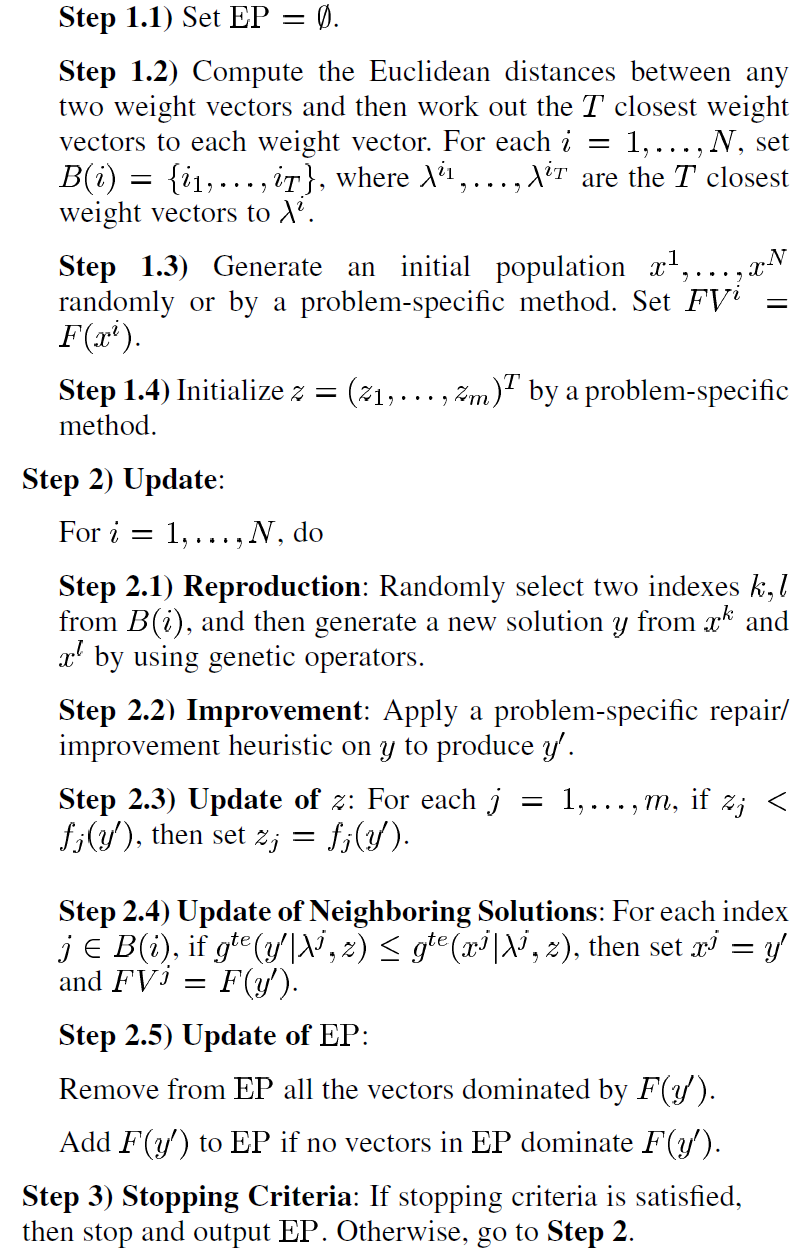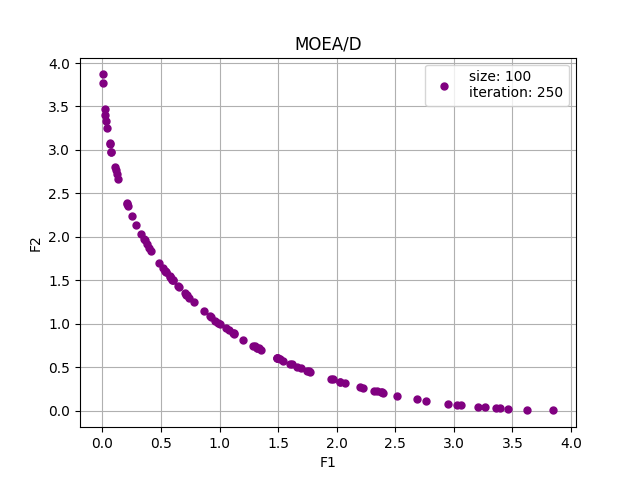MOEA/D: A Multiobjective Evolutionary Algorithm Based on Decomposition
创始人
2024-05-29 18:11:02
0次
目录
- 1 问题定义
- 2 算法步骤
- 3 代码
- 4 效果
1 问题定义
本博客以最小化问题为例
f1=x2f2=(x−2)2minf=(f1(x),f2(x))\begin{aligned} f_1 & = x ^2 \\ f_2 & = (x - 2) ^2 \\ \min f & = (f_1(x), f_2(x)) \end{aligned} f1f2minf=x2=(x−2)2=(f1(x),f2(x))
代码
def func1(population):res = population[:, 0] ** 2return resdef func2(population):res = (population[:, 0] - 2) ** 2return res
2 算法步骤

- EPEPEP:外部种群,大小一般为10∗size10 * size10∗size(sizesizesize是种群大小)
- λ\lambdaλ:权重向量,本文所提到的权重向量需要均匀分布,可以用numpy正态分布产生。
- zzz:是当代种群,每个目标的最小值
- B(i)B(i)B(i):当前点的邻居索引,邻居的计算使用欧氏距离,可以调用sklearn中的库完成
- gte(x∣λj,z∗)=max{λij∣fi(x)−z∗∣}g^{te}(x|\lambda ^j, z^*) = \max\{\lambda_i^j|f_i(x) - z^*|\}gte(x∣λj,z∗)=max{λij∣fi(x)−z∗∣},其中1≤i≤m1 \leq i \leq m1≤i≤m(切比雪夫)
因为本博客以最小化问题为例,而原论文则是求解最大化问题,因此上方图片中要做如下修改
Step 2.3中的 zj>fj(y′)z_j > f_j(y')zj>fj(y′)
注意:当目标数m<=2时适合用切比雪夫
3 代码
import numpy as np
import pandas as pd
from geatpy.core.ndsortESS import ndsortESS # 非支配排序
from sklearn.neighbors import NearestNeighbors # K近邻分类器
from geatpy.operators.mutation.Mutpolyn import Mutpolyn # 多项式变异
from geatpy.operators.recombination.Recsbx import Recsbx # 模拟二进制交叉
from geatpy.visualization.PointScatter import PointScatter # 画图
from untils.SCH import func1, func2# 通过Euclidean distance产生近邻
def get_neighbor(matrix, n_neighbors = 2):nbrs = NearestNeighbors(n_neighbors=n_neighbors, algorithm='kd_tree', metric='euclidean').fit(matrix)distances, indices = nbrs.kneighbors(matrix)return indices # 返回邻居索引# 在邻居集合里挑选两个邻居, 返回邻居索引
def select_neighbor(neighbor_indexs, prob_neighbor = 0.9):indices = []for index in neighbor_indexs:if len(indices) > 2: breakprobability = np.random.rand()if probability < prob_neighbor:indices.append(index)if len(indices) == 0:return neighbor_indexs[0:2]return indices # 返回邻居索引# 切比雪夫方法更新邻居解
def update_neighbor(weight_vector, neighbor_func, z, y_func):# 第一行 对应的为y的相关值copy_func = np.copy(neighbor_func)copy_func = np.abs(copy_func - z) # 函数值 - 参考点te = np.multiply(weight_vector, copy_func) # 叉乘y_te = np.multiply(weight_vector, np.abs(y_func-z))row_max = np.max(te, axis=1)bad_neighbor = []n = row_max.shape[0]for i in range(n):if np.max(y_te) <= row_max[i]: # 需要对邻居更新bad_neighbor.append(i)return bad_neighbordef update_external_population(pop, func, y, y_func): # pop: 外部种群;func: 外部种群函数值if pop is None:pop = yfunc = y_funcelse:pop = np.row_stack((pop, y))func = np.row_stack((func, y_func))levels, criLevel = ndsortESS(func)levels = levels.astype('i4') # float -> intpd_levels = pd.DataFrame(levels) # numpy -> pandasrank_group = pd_levels.groupby(0).groups # 等级分组best_rank = rank_group[1].values # 最好等级的所有下标pop = pop[best_rank, :]func = func[best_rank, :]if func.shape[0] > K * size:r = np.random.randint(0, K * size, 1)pop = np.delete(pop, r, axis=0)func = np.delete(func, r, axis=0)return pop, funcif __name__ == '__main__':size = 50 # 种群大小dim = 2 # 目标函数的个数n = 1 # 决策变量的个数n_neighbor = 50 # 权重向量近邻的个数lb = np.full(n, -10) # 自变量下限ub = np.full(n, 10) # 自变量上限varTypes = np.full(n, 0) # 离散 or 连续iteration = 250 # 迭代次数K = 2 # 外部种群大小 = K * sizenp.random.seed(1)# ===================== 产生均匀分布的权重向量 =======================weight_vector = np.random.randn(size, dim)ss = np.sum(weight_vector, axis=1)for k in range(dim):weight_vector[:, k] = weight_vector[:, k] / ss# ===================== 产生均匀分布的权重向量 =======================all_neighbor = get_neighbor(weight_vector, n_neighbor)# ========================= 产生随机种群 ===========================x = np.random.uniform(lb, ub, (size, n))func = np.column_stack((func1(x), func2(x)))ideal_points = np.min(func, axis=0) # 所有函数值的最小值,即理想点# ========================= 产生随机种群 ===========================exter_pop = None # 外部种群exter_obj = None # 外部种群函数值PS = PointScatter(dim, True, True, "MOEA/D", ['F1', 'F2', 'F3'], saveName=None)for i in range(iteration):print(i)for s in range(size):# ========================= 挑选两个邻居 ==========================neighbor = all_neighbor[s, :] # 当前个体的邻居索引two_neighbor = np.random.choice(neighbor, size = 2, replace=False)neighborsX = x[two_neighbor, :]# ========================= 挑选两个邻居 ==========================# ======================== 进行交叉变异操作 =========================recsbx = Recsbx(XOVR=1, Half_N=True, n=20, Parallel=True) # 交叉y = recsbx.do(neighborsX)mutation = Mutpolyn(Pm=1/n, DisI=20) # 变异y = mutation.do(Encoding='RI', OldChrom=y, FieldDR=np.array([lb, ub, varTypes]))# ======================== 进行交叉变异操作 =========================# ============================= 更新z ==============================y_func = np.column_stack((func1(y), func2(y)))for d in range(dim):ideal_points[d] = np.minimum(ideal_points[d], y_func[0, d])# ============================= 更新z ==============================# =========================== 更新邻居解 ============================weight_vector_neighbor = weight_vector[neighbor, :] # 邻居的权重向量neighborsFunc = func[neighbor, :] # 邻居的函数矩阵bad_neighbor = update_neighbor(weight_vector_neighbor, neighborsFunc,ideal_points, y_func)x[bad_neighbor, :] = yfunc[bad_neighbor, :] = y_func# =========================== 更新邻居解 ============================# =========================== 更新外部种群 ============================exter_pop, exter_obj = update_external_population(exter_pop, exter_obj, y, y_func)# =========================== 更新外部种群 ============================right_label = 'size: ' + str(K * size) + '\n' + 'iteration: ' + str(iteration)PS.add(exter_obj, color='purple', label=right_label)PS.draw()
4 效果

相关内容
热门资讯
保存时出现了1个错误,导致这篇...
当保存文章时出现错误时,可以通过以下步骤解决问题:查看错误信息:查看错误提示信息可以帮助我们了解具体...
汇川伺服电机位置控制模式参数配...
1. 基本控制参数设置 1)设置位置控制模式 2)绝对值位置线性模...
不能访问光猫的的管理页面
光猫是现代家庭宽带网络的重要组成部分,它可以提供高速稳定的网络连接。但是,有时候我们会遇到不能访问光...
表格中数据未显示
当表格中的数据未显示时,可能是由于以下几个原因导致的:HTML代码问题:检查表格的HTML代码是否正...
本地主机上的图像未显示
问题描述:在本地主机上显示图像时,图像未能正常显示。解决方法:以下是一些可能的解决方法,具体取决于问...
表格列调整大小出现问题
问题描述:表格列调整大小出现问题,无法正常调整列宽。解决方法:检查表格的布局方式是否正确。确保表格使...
不一致的条件格式
要解决不一致的条件格式问题,可以按照以下步骤进行:确定条件格式的规则:首先,需要明确条件格式的规则是...
Android|无法访问或保存...
这个问题可能是由于权限设置不正确导致的。您需要在应用程序清单文件中添加以下代码来请求适当的权限:此外...
【NI Multisim 14...
目录 序言 一、工具栏 🍊1.“标准”工具栏 🍊 2.视图工具...
银河麒麟V10SP1高级服务器...
银河麒麟高级服务器操作系统简介: 银河麒麟高级服务器操作系统V10是针对企业级关键业务...